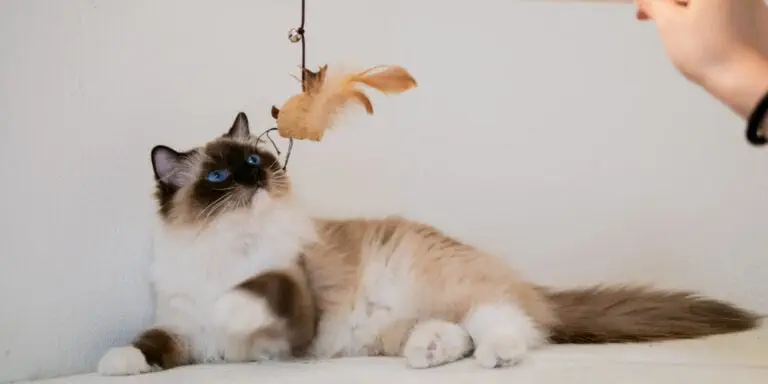The Best Fluffy Pancakes recipe you will fall in love with. Full of tips and tricks to help you make the best pancakes.

As the saying goes, ‘home is where the heart is,’and for many pet owners, that sentiment couldn’t ring truer. For those with a furry friend, their pet is not just a companion, but a beloved member of the family.
If you’re the proud owner of a Ragdoll cat, you know firsthand just how much love and affection these gentle giants can bring into your life. However, like any pet, it’s important to consider their needs and well-being when it comes to leaving them alone.
So, can Ragdolls be left alone?
Ragdolls are social cats and enjoy human companionship, so it is not recommended to leave them alone for extended periods of time. They can become anxious, bored, and even destructive in the absence of human interaction. It is best to have another companion or a pet sitter to keep them company when you are away.
In this article, we’ll explore the ins and outs of Ragdoll cats, their temperament, and what signs to look out for that indicate they may not be comfortable being left alone. We’ll also provide tips and advice on how to keep your Ragdoll happy and healthy, whether you’re at home or away.
Understanding Ragdoll Cats
Ragdoll cats are known for their docile and affectionate personalities, making them great companions for families and individuals alike. They are one of the largest cat breeds, with males weighing up to 20 pounds and females up to 15 pounds. Their signature trait is their relaxed and floppy nature when picked up, hence the name ‘ragdoll.’
In terms of grooming, Ragdolls have a thick, silky coat that requires regular brushing to prevent matting. They also have a tendency to shed, so it’s important to brush them at least once a week. Additionally, Ragdolls are known for their blue eyes, which require regular cleaning to prevent discharge buildup.
When it comes to leaving Ragdolls alone, it’s important to note that they are social creatures who thrive on human interaction. While they can be left alone for short periods of time, it’s not recommended to leave them alone for extended periods of time. They may become anxious or depressed without regular human interaction and play. It’s important to ensure they have plenty of toys and scratching posts to keep them entertained while you’re away.
Can Ragdolls Be Left Alone?
You don’t want to leave your furry companion high and dry like a ship without a captain on rough seas. Ragdoll cats are known for their docile and affectionate temperament, but can they be left alone? The answer depends on several factors, including the cat’s age, personality, and level of separation anxiety.
Ragdolls are generally laid-back cats that enjoy spending time with their owners. They’re not known for being destructive or mischievous when left alone, unlike some other breeds. However, it’s important to remember that every cat is unique, and some may experience separation anxiety when left alone for extended periods.
If you plan on leaving your Ragdoll alone for an extended period, it’s essential to make sure they have access to food, water, and a litter box. Additionally, leaving toys and scratching posts can help keep them occupied and prevent boredom.
If your cat shows signs of separation anxiety, such as excessive meowing or destructive behavior, it may be necessary to hire a pet sitter or ask a friend to check on them regularly. With proper preparation and attention to your cat’s needs, it’s possible to leave your Ragdoll alone without any issues.
Signs of Distress and Anxiety
If you’re planning to leave your Ragdoll alone for an extended period of time, it’s important to know the signs of distress and anxiety they may exhibit.
Keep an eye out for behavioral changes such as excessive meowing or destructive behavior, as well as physical symptoms like vomiting or diarrhea.
These signs can indicate that your Ragdoll is experiencing stress and may need extra attention or care.
Behavioral Changes
When left alone, Ragdolls may experience behavioral changes such as increased anxiety or destructive behavior. This is because Ragdolls are social animals and they thrive on human interaction and affection.
When they are left alone for long periods of time, they may become anxious and stressed, which can lead to a variety of behavioral changes. Some of the most common behavioral changes that Ragdolls may exhibit when left alone include:
- Excessive meowing or crying: Ragdolls are known for their vocalizations, but when they are left alone, they may become more vocal and start meowing or crying excessively.
- Destructive behavior: Ragdolls may scratch furniture, chew on cords, or engage in other destructive behavior when left alone.
- Litter box issues: When Ragdolls are stressed or anxious, they may stop using their litter box and start urinating or defecating in inappropriate places.
- Hiding or avoiding human interaction: When Ragdolls are left alone for long periods of time, they may become fearful or anxious and start hiding or avoiding human interaction altogether.
To prevent these behavioral changes, it’s important to provide your Ragdoll with environmental enrichment and to help them cope with separation anxiety. This can include providing them with toys and puzzles to keep them mentally stimulated, leaving a radio or TV on for background noise, and considering the use of calming pheromone sprays or diffusers.
It’s also important to gradually increase the amount of time your Ragdoll spends alone, and to make sure they have access to food, water, and a comfortable place to rest while you’re away. By taking these steps, you can help your Ragdoll feel more comfortable and secure when left alone.
Physical Symptoms
As your furry friend experiences separation anxiety, they may physically manifest symptoms such as loss of appetite, vomiting, or diarrhea due to stress. They may also exhibit destructive behavior such as chewing or scratching furniture, doors, or windows in an attempt to escape. These physical symptoms can not only cause discomfort for your pet but also lead to costly vet bills.
It’s important to address these physical symptoms of separation anxiety as soon as possible. One way to do this is by gradually increasing the amount of time your ragdoll is left alone, providing them with interactive toys or puzzle feeders to keep them occupied.
Additionally, seeking the advice of a veterinarian or animal behaviorist can provide you with personalized solutions to help alleviate your ragdoll’s stress and improve their overall well-being.
Tips for Keeping Your Ragdoll Happy and Healthy
To keep your ragdoll happy and healthy, make sure to provide plenty of toys and scratching posts. Ragdolls are known for their playful and curious nature, and they require mental stimulation to prevent boredom and destructive behavior. Interactive toys, such as puzzle feeders or laser pointers, are great for keeping your ragdoll entertained and mentally stimulated.
In addition to providing toys, it’s important to establish a routine for your ragdoll. Set aside dedicated playtime each day, and make sure to provide plenty of opportunities for exercise. This can include playing with toys, going for walks on a leash, or even setting up a cat tree for climbing and jumping.
Make sure to provide a comfortable and safe environment for your ragdoll. They should have access to cozy beds and plenty of hiding spots, as well as clean litter boxes and fresh water. By providing a stimulating and comfortable environment, you can help ensure that your ragdoll stays healthy and happy for years to come.
Hiring a Pet Sitter or Using Boarding Services
If you’re in need of a break, consider hiring a pet sitter or using boarding services to ensure your furry friend is well taken care of while you’re away. Both options have their advantages and disadvantages, so it’s important to weigh them carefully.
A pet sitter is a great option if your cat prefers to stay in its own environment. A sitter can come to your home, feed your cat, change its litter, and play with it. Your cat will also receive individual attention, which is important for breeds like the Ragdoll that crave human interaction. However, pet sitters can be expensive, especially if you need someone to come multiple times a day. You also need to find someone reliable and trustworthy, as you’ll be entrusting them with your home and your cat.
Boarding services are another option for Ragdoll owners. These services provide a safe and secure environment for your cat while you’re away. Your cat will be fed, have access to clean litter, and will receive exercise and socialization. However, some cats don’t adapt well to new environments and may become stressed or anxious. Boarding services can also be expensive, especially if you’re going away for an extended period of time. It’s also important to research the facility and read reviews to ensure that your cat will be well taken care of.
Training Your Ragdoll to Be Alone
Are you struggling to leave your beloved Ragdoll at home without feeling guilty? Don’t worry, there are ways to train them to be comfortable when you’re away. Teaching your cat to be independent is crucial to their well-being, and it can also help prevent separation anxiety. Here are some tips to help your Ragdoll learn to be alone:
Start by gradually increasing the amount of time your cat spends alone. Leave them in a separate room for a few minutes at a time, then increase the time gradually. Make sure they have plenty of toys, food, and water to keep them occupied while you’re away. If your cat is struggling, try leaving a piece of clothing with your scent on it to comfort them.
Another way to teach your Ragdoll to be alone is by providing them with a designated space. This could be a cat tree, a bed, or a cozy nook in your home. Encourage your cat to use this space regularly, and reward them with treats or affection when they do. This will help your cat associate their space with positive experiences and make them more comfortable when you’re not around.
Training your Ragdoll to be alone is an important part of their overall well-being. By teaching them independence and preventing separation anxiety, you can ensure that your cat is happy and healthy. With patience and consistency, your Ragdoll will learn to be comfortable when you’re away, and you can enjoy your time outside of the house without feeling guilty.
Common Mistakes to Avoid
One mistake you might be making is assuming that your Ragdoll will automatically know how to behave when you’re not around. Separation anxiety is a common issue among cats, including Ragdolls, and it can lead to destructive behavior when left alone. It’s important to understand that your Ragdoll needs to be trained to be comfortable with being alone.
To avoid separation anxiety and destructive behavior, start by gradually increasing the amount of time your Ragdoll spends alone. Begin by leaving them alone for short periods of time, and gradually increase the time as they become more comfortable. You can also provide your Ragdoll with toys, scratching posts, and other items to keep them occupied while you’re away.
Another mistake to avoid is punishing your Ragdoll for destructive behavior when you return home. This can actually make the separation anxiety worse, as your Ragdoll will associate your return with punishment. Instead, provide positive reinforcement when your Ragdoll behaves well while you’re away. This can include treats, praise, and extra attention when you return home.
With patience and training, you can help your Ragdoll feel comfortable and secure when left alone.
Are Ragdolls more independent than other cat breeds?
Ragdoll cats are known for their gentle and relaxed demeanor, making them seem less independent than other cat breeds. However, their loyalty and affectionate nature are why ragdoll cats special. They often seek human companionship and enjoy being around people, making them less independent in comparison to some other breeds.
Conclusion
In conclusion, Ragdoll cats can be left alone, but it’s important to understand their needs and behavior. As social creatures, Ragdolls may experience distress and anxiety when left alone for extended periods of time. However, with proper training, care, and attention, you can keep your Ragdoll happy and healthy even when you’re away.
According to a survey conducted by the American Pet Products Association, about 10% of cat owners hire pet sitters or use boarding services when they’re away from home. This statistic highlights the importance of providing adequate care and attention to your Ragdoll when you cannot be there for them.
Whether you choose to hire a pet sitter or train your Ragdoll to be alone, it’s crucial to prioritize their physical and emotional well-being. By following the tips and advice in this article, you can ensure that your Ragdoll is a happy and content companion even when you’re not around.








